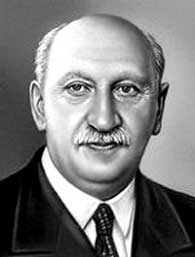.
Abram Fedorovich Ioffe

Abram Fedorovich Ioffe (Russian: Абра́м Фёдорович Ио́ффе, October 29 [O.S. October 17] 1880 – October 14, 1960) was a prominent Soviet/Russian physicist born in Ukraine. He was awarded Stalin Prize in 1942, Lenin Prize in 1960 (posthumously), Hero of Socialist Labor in 1955.
Career overview
In the course of his career, Ioffe researched electromagnetism, radiology, features of crystals, physics of high impact, thermoelectricity, photoelectricity, and was a leading force in building new research laboratories for radioactivity, superconductivity, and nuclear physics. Many of these laboratories later became independent institutes.
Ioffe's pedagogical efforts resulted in the Soviet school of physics, his students include Aleksandr Aleksandrov, Yakov Dorfman, Pyotr Kapitsa, Isaak Kikoin, Igor Kurchatov, Yakov Frenkel, Nikolay Semyonov, Lev Artsimovich and others.
Biography
Born to a middle-class Jewish family in small town of Romny, Russian Empire (now in Sumy region, Ukraine), after graduation in (1902) from Saint Petersburg State Institute of Technology he worked for two years as an assistant to famous Wilhelm Roentgen in his Munich laboratory. In 1905 Ioffe obtained Ph.D. from Munich University. Ioffe stated that he saw the names of two authors, Einstein – Marić, on the 1905 Annus Mirabilis papers when they were submitted during this time. This is claimed to lend support to claim that the work was a co-authorship between Einstein and his wife, though most historians of science do not think this is so.[1]
After 1906 Ioffe worked in the St. Petersburg (from 1924 Leningrad) Polytechnical Institute, where later became a professor. In 1911 Ioffe converted to Lutheranism in order to marry a non-Jew.[2] In 1913 he attained the title of Magister of Philosophy, in 1915 - Doctor of Physics. In 1918 he became a head of Physics and Technology division in State Institute of Roentgenology and Radiology. This division later became the Ioffe Physico-Technical Institute.
Ioffe refused a job offer of directing the Soviet project to build the nuclear bomb on account of being too old. He saw great promise in the young Igor Kurchatov, and in 1942 placed him in charge of the first nuclear laboratory. During the Stalin's campaign against the so-called "rootless cosmopolitans" (Jews), in 1950 Ioffe was made redundant from his position of the Director of Institute and from the Board of Directors. In 1952-1954 he headed the Laboratory of Semiconductors of Academy of Sciences of the USSR, which in 1954 was reorganized into Institute of Semiconductors.
Ioffe attained a US Patent on the piezoelectric effect.
Related
* Ioffe crater on the Moon is named after him.
* Ioffe Physico-Technical Institute carries his name
* The Russian oceanographic and Polar research vessel Akademik Ioffe is named after him.
Patents
* U.S. Patent 1,807,292 "Translating device"
References and external link
1. ^ "Einstein's Wife : The Mileva Question". Oregon Public Broadcasting, 2003
2. ^ Abram Ioffe article in Electronic Jewish Encyclopedia (Russian)
* Annotated bibliography for Abram Ioffe from the Alsos Digital Library for Nuclear Issues
Retrieved from "http://en.wikipedia.org/"
All text is available under the terms of the GNU Free Documentation License

